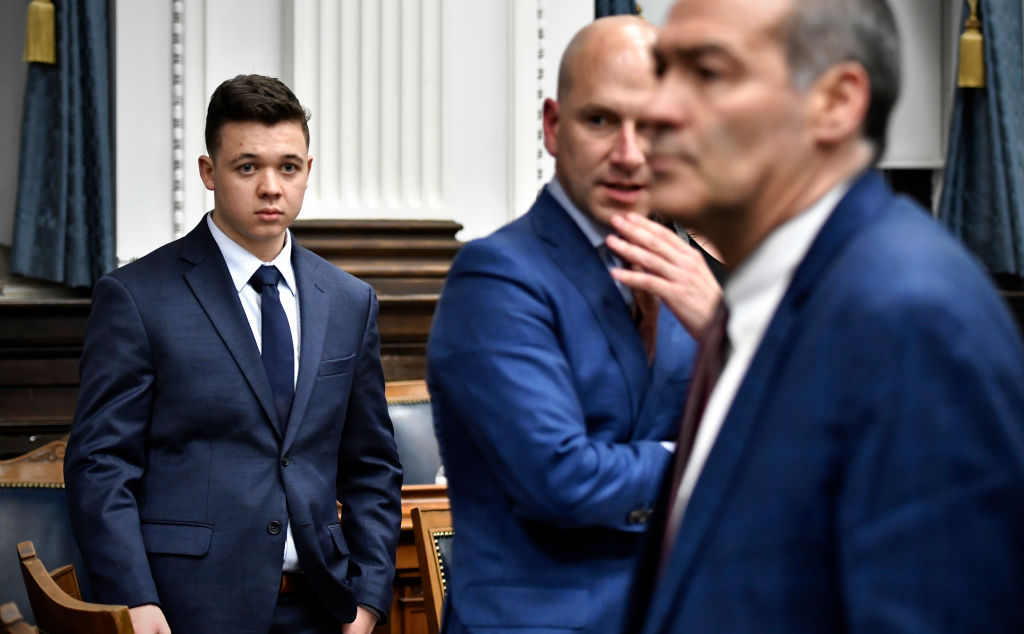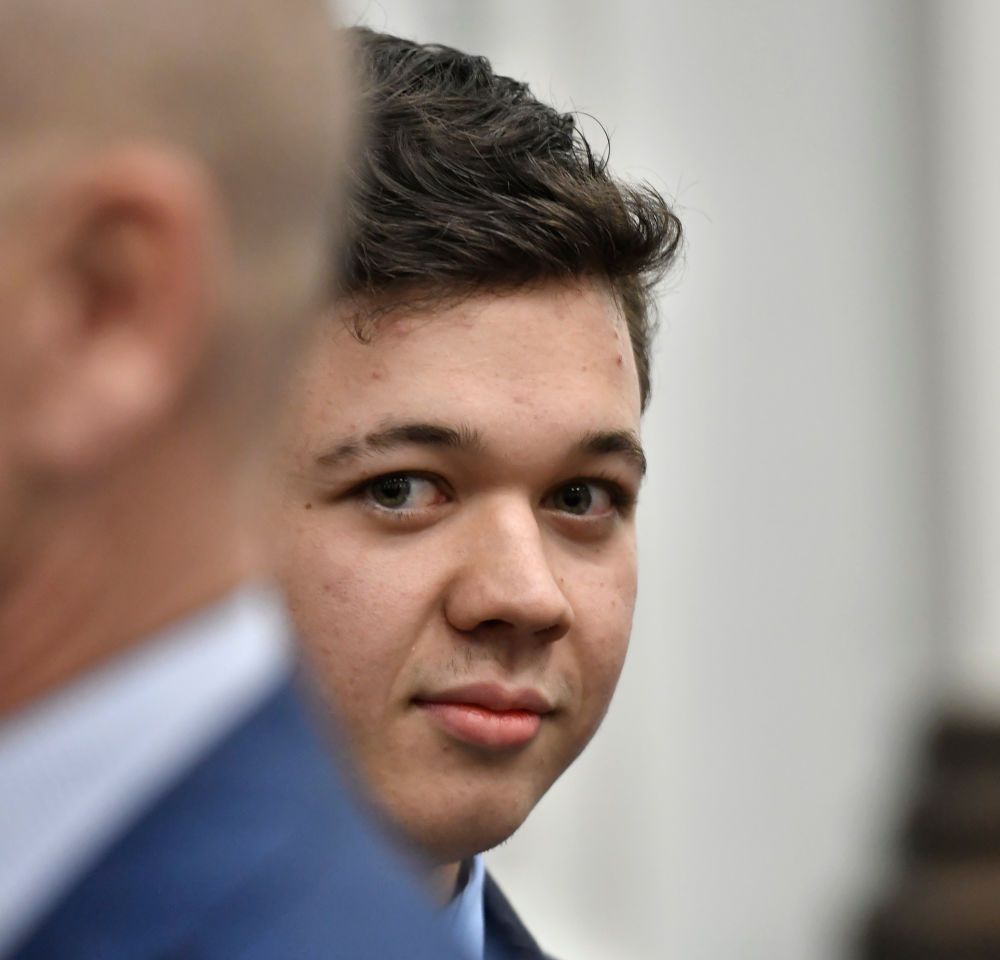Kyle Rittenhouse Cries (Or Fake Cries?) While Testifying At Murder Trial
Kyle Rittenhouse Murder Trial: Some People Are Buying The ‘Crying’ Act, But Where Were The Tears?

Source: Pool / Getty
Earlier this week, we asked what the possibility of Kenosha shooter Kyle Rittenhouse testifying in his own defense could mean for his murder trial. Well, on Wednesday, the world saw the 18-year-old on the witness stand, and some legal experts all appear to believe his testimony came off as genuine and ultimately worked in his favor, but others believe he appeared to have been coached.
Then there’s the “crying” he did on the stand—that cringy, tearless, probably fake ugly crying that might have earned him an Oscars-so-white award if the academy were allowed to vote him in.
First, let’s start with what Rittenhouse said in his testimony, and what legal experts told the Associated Press they thought of his performance.
Rittenhouse testified that Joseph Rosenbaum, one of the two men he’s accused of killing, threatened to kill him twice, chased after him and grabbed for his gun, forcing the now-18-year-old to shoot. He also said Anthony Huber, the other man he killed, hit him with a skateboard twice and also tried to take his gun. Finally, he said Gaige Grosskreutz, the sole survivor of Rittenhouse’s alleged shooting spree, pointed a pistol at him before Rittenhouse shot him.
It’s worth noting here that Grosskreutz testified on Monday that he was armed and he unholstered his gun as he and a crowd chased Rittenhouse after he shot and killed Rosenbaum, according to CNN, which also reported that “Rittenhouse fell to the ground, fired twice at an unknown person and then fatally shot Anthony Huber.”
Grosskreutz testified that after Rittenhouse fired those shots, the 27-year-old paramedic put his hands in the air, which was confirmed by video footage, CNN reported. Grosskreutz said on the witness stand that Rittenhouse then reracked his rifle.
“Reracking the weapon in my mind meant that the defendant pulled the trigger while my hands were in the air, but the gun didn’t fire, so by reracking the weapon I inferred the defendant wasn’t accepting my surrender,” he testified, adding that he “was never trying to kill the defendant.”
Phil Turner, a Chicago-based defense attorney and former federal prosecutor, told AP he felt Rittenhouse’s Wednesday testimony “solidified his defense and showed himself to be very human,” and that “his crying appeared very genuine. I think the jury got more of a sense of him as a young person.”
Waaaait a minute. What crying “appeared very genuine?”
Certainly, Turner isn’t talking about this D-list-level dry-blubbering performance here:
Let’s take a quick break from talking about the trial to look at what the Twitter world thought of Rittenhouse and his white-but-also-invisible tears.
https://twitter.com/TanyaEverywhere/status/1458479887354941446
Even LeBron James had to get in on this drag.
Others pointed out that Rittenhouse didn’t have that same energy when he was posing for photos with Proud Boys members at a bar fresh off of being released on bail.
https://twitter.com/OleGelo5/status/1458479226227679235
Anyway, Turner also told AP that “from what I could see of the cross-examination, it was way off-target.”
Now, he might have been right about that one.
Assistant District Attorney Thomas Binger began his cross-examination by insisting that Rittenhouse intended to kill his victims, which really only gave Rittenhouse the opportunity to be heard repeatedly denying he was there to kill and claiming he was only defending himself. Binger also asked Rittenhouse if he played “shoot-’em-up video games,” AP reported.
I mean, come on, bruh, blaming violent video games for gun violence didn’t work in the ’90s, and it sure as hell isn’t going to work in damn near 2022.
Then Binger made the mistake of asking Rittenhouse why he was talking about the shootings now for the first time, but all that did is get him admonished by Judge Bruce Schroeder because—and Binger might want to sit down for this one—suspects have the right to remain silent when accused of a crime.
“This is a grave constitutional violation for you to talk about the defendant’s silence,” Schroeder told Binger. “You’re right on the borderline. And you may be over. But it better stop.”
But Binger wasn’t done making dumb mistakes yet as he then began to ask Rittenhouse about a video that shows him telling his friend 15 days before the protests that he would like to shoot suspected shoplifters. Schroeder had already ruled that evidence wouldn’t be allowed—although, only White Jesus could explain why—but he said he might revisit the ruling later. But Binger went down that road without permission, and that act coupled with his questioning of Rittenhouse’s initial silence led to the defense requesting a mistrial, which Schroeder said he will consider.
While some legal experts told AP Rittenhouse’s testimony was a positive for the defense, Laurie Levenson, a law professor at Loyola Marymount University, said she thought he came off as “quite coached.”
“This is a big credibility call for the jury,” she said. “The jury can either see (Rittenhouse) as a clueless kid or he’s trying to evade answering questions. It can hurt him if the jury doesn’t think he’s sincere.”
SEE ALSO:
As Prosecution Rests Case, Kyle Rittenhouse’s Trial Reaches Midway Point
Kyle Rittenhouse Juror Who Joked To Cop About Jacob Blake Shooting Gets Dismissed From Case




